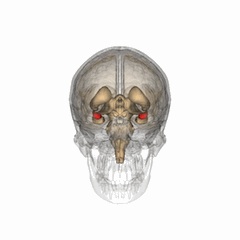McGaugh & Cahill (1995)
 McGaugh & Cahill carried out a classic study of flashbulb memory. You can use this study for the following learning objectives:
McGaugh & Cahill carried out a classic study of flashbulb memory. You can use this study for the following learning objectives:
Discuss how and why particular research methods are used in the biological approach.
Explain the function of hormones in human behaviour.
To what extent is one cognitive process reliable?
One theory of how emotion may affect one cognitive process.
The abstract of the original study is available here. The version with beta-blockers is available here.
If you experience a traumatic event like a car crash the physiological stress system automatically gets going. The body’s “fight or flight” response kicks in and your heart starts beating faster. This is because stress hormones like adrenaline and cortisol are released from the adrenal gland. When adrenaline reaches the brain it activates the amygdala to send a message that something important or dangerous has happened. The amygdala is believed to play an important role in emotional aspects of memory in that it attaches emotional significance to otherwise neutral stimuli.
Generally, researchers believe that an “emotional memory” is better remembered and they argue that this is because the amygdala is in communication with other brain regions when a memory is created. The following experiment by McGaugh & Cahill is evidence of the important role that the amygdala plays in the creation of flashbulb memories.
The aim of McGaugh and Cahill's study was to study the role of emotion in the creation of memories.
Participants were divided into two groups. Each group saw 12 slides which were accompanied by a very different story. In the first condition, the participant heard a rather boring story about a woman and her son who paid a visit to the son’s father in a hospital where they witnessed the staff in a disaster preparation drill of a simulated accident victim.
In the second condition, the participant heard a story where the boy was involved in a car accident where his feet were severed. He was quickly brought to the hospital where the surgeons reattached the injured limbs. Then he stayed in the hospitals for some weeks and then went home with his mother.
After viewing the slides, the participants were asked how emotional they found the story on a scale of 1 - 10. Two weeks after participating in the experiment the participants were asked to come back and their memory for specific details of the story were tested. The test was a recognition task that consisted of a series of questions about the slides with three options for them to choose from. For example, what was the job of the father of the boy in the story? A. A janitor B. A lab technician C. A surgeon.
The researchers then did a follow-up study. In the follow-up study (McGaugh & Cahill,1996), the above procedure was repeated, but this time the participants in the "traumatic story" condition were injected with either a beta-blocker called propranolol or a placebo. This is a drug that is used to treat heart disease because the beta-blockers block target cells for the hormone so that the heart will pump more slowly and efficiently. However, in this study, it was used to prevent activation of the amygdala.
In the original version of the experiment, the researchers found that the participants who had heard the more emotionally arousing story demonstrated better recall of specific details of the story. They could also recall more details from the slides. In the follow-up study, they found that those that had received the beta-blocker did no better than the group that had heard the "mundane" story. They, therefore, concluded that the amygdala plays a significant role in the creation of memories linked to emotional arousal.
The fact that the researchers could block adrenaline in an experimental design gives rise to a cause-and-effect relationship between adrenaline and activation of the amygdala to create emotional significance of the story.
The research has been applied to the treatment of PTSD patients. Pitman et al (2002) carried out a study where patients coming into emergency rooms after traumatic events such as car accidents were given beta-blockers for 19 days. One month after the traumatic event, people who had the drug showed fewer symptoms of PTSD than similar patients who did not receive the drugs.
The study is artificial in nature and highly controlled. Therefore, there is a concern about ecological validity.
The study can be easily replicated because of its standardized procedure, allowing other researchers to test the reliability of the results.
As the recognition task only had three options, it is possible that this is not a valid test of memory. However, there was a significant difference between the total recall of the participants in the different test conditions, so the study demonstrates internal validity.

 IB Docs (2) Team
IB Docs (2) Team
